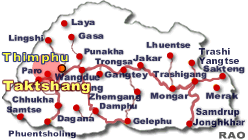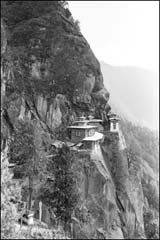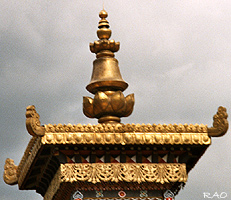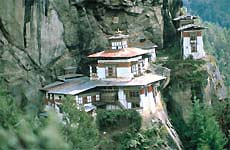 |
Monasteries
in Bhutan |
|
 |
Bhutan Information |
|
|
 |
|
The
Royal Family in Taktshang
|
 |
| His
Majesty the King, Their Majesties the Queens, the Chairman of the Lhengye
Zhungtshog, Lyonpo Yeshey Zimba, the Home Minister and government officials
offered prayers at Taktshang Monastery. |
 |
His
Majesty also inspected the progress of the restoration work on the monastery
which was damaged by fire in April 1988 and spoke to the clergy, officials, engineers and architects, the traditional
craftsmen, and workers at the restoration site during the royal visit.
His Majesty emphasised the importance of the task of reconstructing one
of the most sacred nyes in the Buddhist world and expressed his satisfaction
with the significant progress which had been made. |
His
Majesty said that the restoration of the historic monument would also strengthen
the faith of the Bhutanese people and benefit the country.
 |
Taktshang
| With
the spiritual essence of the nye remaining inviolable and the Pelphug
(sacred cave where Guru Rinpoche meditated in the 8th
century) undisturbed by the fire, the reconstruction work focused on the outer structures
around this most sacred sanctum of Taktshang. Apart from the Pelghug,
the Kudung (relics) of Langchhen Pelkyi Singye were untouched, and
many nangtens were recovered. The Nye Khang, dedicated to Singye
Samdrup, the guardian deity of Taktshang, was not damaged by
the fire. The Drubkhang where Gyalse Tenzin Rabgye was believed
to have cut his hair as a symbolic gesture to anchor the foundation on
the edge of the cliff was left intact and did not need restoration.
The
actual restoration work began in April, 2000,
after a Sa Chhoe Jhin Gi Lap (blessing of the site) service by His
Holiness the Je Khenpo and a Tshewang by Gyalse Tenzin Rabgye. |
|
Within
seven months, several important structures were completed. Among them was
the Taktshang Pelphug which houses three lhakhangs: the Phurpai
Dubkhang on the ground floor where Guru Rinpoche meditated;
the Guru Sungjoen Lhakhang, situated on the first floor of the building
and named after the image of the Guru which is believed to have
spoken; and the Guru Tshen Gyed Lhakhang, on the top floor, named
after the eight manifestations of Guru Rinpoche.
Sertog
of Chimi Lhakhang in Lobesa
| The Guru
Dorji Droloe Lhakhang has also been completed with some improvements
made on the overall design. The sertogs (gilded pinnacles) for the Pelphug
Lhakhang and Guru Dorji Droloe Lhakhang were installed on December
10, 2000.
The extension of the Guru Tshengyed Lhakhang, where the annual ceremonies
are performed, was carried out without compromising the overall design
of the lhakhang. "The new structures will be an exact replica of
the old monastery," said the Tensoi Lapon, Dasho Zepon Wangchuk. "The work
is progressing so well that we might complete the restoration well ahead
of schedule." The next phase of the reconstruction is focused on the Kuenrey and Chorten Lhakhang. |
|
 |
A
fire proof structure (methub) will be constructed in the Chorten
Lhakhang to safeguard the sacred nangtens from fire and theft.
top
|
Fire
in Taktshang
|
 |
The
restoration of the Taktshang Monastery was commanded by His Majesty
the King soon after the fire disaster in 1988
AD. It was a royal command that the original
aura, authenticity, and architectural splendour must be preserved at all
cost. The project was immediately mobilised to restore the monastery and
to preserve and strengthen Bhutan's unique spiritual heritage.
The
project has been widely seen as an act of devotion, involving all sections
of Bhutanese society, and as a homage to the nation's heritage. It also
proved to be an opportunity for Bhutan's traditional artists and craftsmen
to hone the skills inherited from their forefathers down the ages. With
the full support of the government, and the efforts of craftsmen and workers,
a large number of people have made voluntary contributions to the restoration
project with cash offerings, labour, or by providing meals to the workers.
With
the absence of adequate architectural Document of the monastery's structures,
designers studied the damaged parts, consulted all the caretakers and the
craftsmen who were involved in the maintenance of the monastery to perfect
the replication of the original designs. Overhanging rocks loosened by
the fire delayed the work and the sheer cliff and narrow footpath posed
a severe problem for the workers, but all those involved told that these
physical challenges were easily overcome through their spiritual devotion.
A number of government departments are also involved in the restoration
of Taktshang Monastery.
The
initial survey was conducted by the Department of Geology and Mines, the
construction of the road and bridge to Ramthangka was done by the
Department of Roads, the finances are controlled by the dzongkhag administration,
and power is provided by the Department of Power. Traditional skills are
harmonised with modern technology and all the materials are transported
to Taktshang by trucks and then by cable crane 3000 feet up the sheer cliff
face.
 |
| The
physical restoration of Taktshang Monastery has cost about Nu. 39
million. Nu 22 million was spent on the construction of the bridge and
road to Ramthangka, on the base of the sheer rock face where the Taktshang
Monastery sits. The total cost is estimated at about Nu. 80 million
with the restoration of the nangtens, images, and chhoeshams. The legend
of Taktshang (Tiger's lair) dates back to 747
AD when Guru Rinpoche (Padma Sambhava),
in the wrathful form of Guru Dorji Droloe, is believed to have arrived
at this site on the back of a tiger and subdued the evil spirits in the
region. |
|
The Guru then meditated in the holy cave which is the site of the Pelphug Lhakhang.
According to Tantric Buddhist mythology, the vanquished local deities
became the protectors of the dharma and one of them, Singye
Samdrup, is recognised today as the guardian deity of Taktshang. Guru
Rinpoche is also believed to have concealed among the rocks of Taktshang
various forms of Dharma treasures known as Ters which were
destined to be discovered later by Tertons (treasure discoverers) for the propagation of Dharma.
|
more
information on Bhutan
|

|
|





